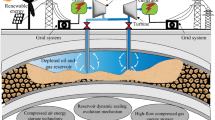Abstract
A thermodynamic assessment of an integrated heat recovery system, which simultaneously recovers both the cold energy of LNG released into seawater and the exhaust gas heat of diesel generator released into ambient air during the regasification process in a LNGFSRU vessel, has been carried out. For the LNG regasification unit consisting of two-stage heat exchangers, a primary Rankine cycle was applied as a typical power cycle of the type A for recovering cold energy to the first-stage heat exchanger. A secondary Rankine cycle of the type B was serially inserted between the first-stage and the second-stage heat exchangers for recovery of the remaining cold energy of preheated LNG. Then, in the type C, the exhaust gas, which had a relatively high temperature, was applied as the heat source of the secondary Rankine cycle, instead of seawater. In such a sequential procedure, the type C was finally suggested as an integrated heat recovery system, in which the seawater and exhaust gas were combined as the heat sources. When the net outputs produced from each heat recovery system were maximized by changing the pressure and mass flow rate of working fluid, the thermal efficiency of the integrated heat recovery system of the type C was η I,EG = 0.0741. The results showed an improvement of approximately 13.3% (25.6%) in the thermal efficiency compared to the value of η I,SW = 0.0654 ( η I = 0.0590) for the conventional cold energy recovery system of the type B (the type A), which only used seawater as the heat source. Based on this finding, a possibility of utilizing the integrated heat recovery system with the combined cycle within the LNG-FSRU was confirmed.
Similar content being viewed by others
References
V. L. Rocca, Cold recovery during regasification of LNG part one: cold utilization far from the regasification facility, Energy, 35 (5) (2010) 2049–2058.
J. Szargut and I. Szczygiel, Utilization of the cryogenic exergy of liquid natural gas (LNG) for the production of electricity, Energy, 34 (7) (2009) 827–837.
I. H. Choi, S. Lee, Y. Seo and D. Chang, Analysis and optimization of cascade Rankine cycle for liquefied natural gas cold energy recovery, Energy, 61 (2013) 179–195.
X. Shi, B. Agnew, D. Che and J. Gao, Performance enhancement of conventional combined cycle power plant by inlet air cooling, inter-cooling and LNG cold energy utilization, Appl. Therm. Eng., 30 (2010) 2003–2010.
T. S. Kim and S. T. Ro, Power augmentation of combined cycle power plants using cold energy of liquefied natural gas, Energy, 25 (9) (2000) 841–856.
K. Kaneko, K. Ohtani, Y. Tsujikawa and S. Fujii, Utilization of the cryogenic exergy of LNG by a mirror gas-turbine, Appl. Energy, 79 (4) (2004) 355–369.
T. Miyazaki, Y. T. Kang, A. Akisawa and T. Kashiwagi, A combined power cycle using refuse incineration and LNG cold energy, Energy, 25 (7) (2000) 639–655.
J. Wang, Z. Yan, M. Wang and Y. Dai, Thermodynamic analysis and optimization of an ammonia-water power system with LNG (liquefied natural gas) as its heat sink, Energy, 50 (1) (2013) 513–522.
G. Oliveti, N. Arcuri, R. Bruno and M. D. Simone, A rational thermodynamic use of liquefied natural gas in a waste incinerator plant, Appl. Therm. Eng., 35 (1) (2012) 134–144.
C. Dispenza, G. Dispenza, V. L. Rocca and G. Panno, Exergy recovery during LNG regasification: electric energy production—Part one, Appl. Therm. Eng., 29 (2009) 380–387.
C. Dispenza, G. Dispenza, V. L. Rocca and G. Panno, Exergy recovery during LNG regasification: electric energy production—Part two, Appl. Therm. Eng., 29 (2009) 388–399.
J. Wang, J. Wang, Y. Dai and P. Zhao, Thermodynamic analysis and optimization of a transcritical CO2 geothermal power generation system based on the cold energy utilization of LNG, Appl. Therm. Eng., 70 (2014) 531–540.
A. Franco and C. Casarosa, Thermodynamic analysis of direct expansion configurations for electricity production by LNG cold energy recovery, Appl. Therm. Eng., 78 (2015) 649–657.
H. Liu and L. You, Characteristics and applications of the cold heat exergy of liquefied natural gas, Energy Convers. Manage., 40 (1999) 1515–1525.
California State Lands Commission, Final Environmental Impact Report for Cabrillo Port LNG Deepwater Port License Application, Appendix G2-1 FSRU Emissions Summary Index (2007).
WARTSILA Engines, WARTSILA 50DF Product Guide (2012).
Aspen Technology, Aspen HYSYS User Guide v7.3 (2011).
D. Y. Peng and D. B. Robinson, A new two-constant equation of state, Ind. Eng. Chem. Fundam., 15 (1) (1976).
F. Dauber and R. Span, Influence of thermodynamicproperty models on the simulation of LNG evaporation and liquefaction processes, IGRC, Paris (2008).
B. C. Choi and Y. M. Kim, Thermodynamic analysis of a dual loop heat recovery system with trilateral cycle applied to exhaust gases of internal combustion engine for propulsion of the 6800 TEU container ship, Energy, 58 (2013) 404–416.
Author information
Authors and Affiliations
Corresponding author
Additional information
Sangick Lee received the B.S. and M.S. from the Department of Oceanography, Seoul National University, Seoul, Korea, in 1999 and 2001, respectively. He received Ph.D. from the Department of Ocean Systems Engineering, Korea Advanced Institute of Science and Technology (KAIST), Daejeon, Korea, in 2014. He is currently a senior researcher in R&D Center, Korean Register of Shipping. His research interests include process systems engineering and risk, reliability and safety of systems.
Byung Chul Choi earned the B.S. and M.S. in Mechanical Engineering from Korea Maritime University, in 2002 and 2004, respectively. In 2010, he earned a Ph.D. in Mechanical Engineering from Seoul National University. He joined the Department of Mechanical Engineering at Massachusetts Institute of Technology in 2015 as a visiting research scholar. His research interest includes the areas of fundamentals of combustion, internal combustion engine, thermal energy conversion & storage and fire & explosion safety.
Rights and permissions
About this article
Cite this article
Lee, S., Choi, B.C. Thermodynamic assessment of integrated heat recovery system combining exhaust-gas heat and cold energy for LNG regasification process in FSRU vessel. J Mech Sci Technol 30, 1389–1398 (2016). https://doi.org/10.1007/s12206-016-0246-y
Received:
Revised:
Accepted:
Published:
Issue Date:
DOI: https://doi.org/10.1007/s12206-016-0246-y




